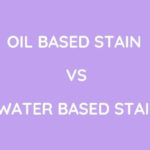The elegance of the household depends on its furniture. Woodworkers decide the paint they would use the wood. Most woodworks are painted/stained with oil-based stains or water-based stains. These stains give the wood glamour. Now, let’s differentiate between the two types of stains by comparing Oil Based Stain Vs Water Based Stain.
Contents
Our Verdict
Staining is the crucial step of woodworking. Oil-based are made of a mixture of linseed and varnish. They are more durable and give a more vivid color. Water-based stain, on the other hand, is the best underwater. They have 40 different colors. In personal opinion, oil-based stains are in for the long run. They have more durability and require less maintenance. But, water-based stains are more eco friendly and release fewer toxins into the atmosphere.
Oil Based Stain Vs Water Based Stain: Comparison Chart
| Specification | Oil-Based Stain | Makita |
|---|---|---|
| Durability | More durability | Less durability |
| Toxicity | Produces more VOC | Produces less VOC |
| Breathability | Less breathability | More breathability |
| Time is taken to dry | Less time is taken | More time is taken |
| Colour appearance | More vivid | Less vivid than an oil stain |
Water Based Stain Vs Oil Based Stain: Differences
1. Durability
Oil-based stain: Oil-based stains are very durable. If opened, it can be kept for one year and unopened for 2-3 years. It gives the woods more even finish. They are made-up of denatured alcohol.
Water-based stain: These stains through eco-friendly have cons. they aren’t very durable as they don’t bond well with wood. They hence don’t give an excellent finish to the wood.
2. Toxicity
Oil-based stain: Oil-based as made of denatured alcohol and linseed releases many toxic substances to the environment. They release more VOCs [volatile organic chemicals]. They are acrylic and made of Urethane binders. Oil-based stains are water-resistant too.
Water-based stain: These emit fewer VOCs than the oil-based stain. They can be cleaned with soap and water very quickly.
3. Breathability
The capacity of penetration depends on the type of wood, [water based stains penetrates deeply into softwoods like cypresses, cedar, etc.]
Oil-based stain: Oil stains tend to have less breathability. they trap moisture. Though that is an advantage, they prevent the elements from penetrating deep into the wood. Hence their breathability is less.
Water-based stain: Water-based stains don’t trap moisture. They would let wood inherit their protection. These mostly work best for less dense woods like cedar etc.
4. Mildew
Oil-based stain: Most oil-based stains are free of mildew, some rare exceptions which would be mentioned in the tin.
Water-based stain: Most water-based stains are mildew resistant. Sometimes, some producers add additives or chemicals, making them increase their mildew produce.
5. Application
Oil-based stain: These stains are flammable. They need to apply in well-ventilated areas. They have a high rate of VOC [volatile organic chemical.
Water-based stain: The application of water-based satin is easier than oil-based stains. They can be cleaned up very quickly too. But most of them raise the grain in the wood. They can be used in an enclosed area, but water-based stains aren’t durable on outdoor furniture.
Bottom Line: Oil-based stains have the most advantages, mostly due to their durability. The use of the stain also depends on the type of wood, what stain was used before, and where it would be placed. If the furniture would be placed outside then, oil-based stains are better off as they’re more resistant to natural elements than water-based stains.
Water Based Stain Vs Oil Based Stain: Features And Technical Specifications
Oil-Based Stain
- Preparation of surface: The surface needs to be clean from area marks and other fine particles of dust. It is then smoothened by fine abrasive paper in one particular direction of the grain. Scratches in the direction of the grain, when stained, make it darker in a tone only on those parts. Stopping is done after staining using a wood filler or tinter.
- Sizing: Softwood is mostly treated with a hot weak size of thinned shellac. A diluted stain is made to soak in wood for the depth of the color. The surface should be completely dry before it is stained.
- Application: Application of the stain is to be done with a brush and then wiped off. Wiping it off is necessary as it hast be thinned when thinned, it helps not to over-stain—softwoods like cedar etcher absorbent and need to be taken care of.
- Hardboard: This is to prevent swelling of the surface from the influence of oil paint. A coat of emulsion is thinned with shellac varnish, or water is applied when dry.
- Particle Board: The surface is filled with brushable filler and finished.
- Insulation Board: Two coats of a thin plastic emulsion is applied after dusting.
Water-Based Stain
- Preparation of surface: Removal of dust with the help of a vacuum or rag is necessary.
- Application: Application of stain and wiping off the excess is vital. Pulling out the surplus of the corners is also indispensable. Let it dry.
- Make sure to apply with a foam brush or paint pad.
- Top-coat is also essential.
Accessories Contained In An Oil-Based Stain Kit:
- Stain block brush
- Oil bristle brush
- Oil flat bristle brush
- stains of required colors
- Accessories Contained in a water-based stain box/kit:
- Stain block brush
- Water blend and water-proofing brush
- Water-based bristle brush
- Flat varnish brush
- Stains of the required color.
Water-Based Stain Vs Oil Based Stain: Overview
Overview of Oil Based Stain
The shine you see on any furniture is due to the staining if the furniture. Oil-based stains are the most used stains. They adapt to all conditions. They can resist all-natural elements like wind, rain, etc. They are flammable But are easy to maintain. They are more water-resistant and nature resistant as well. It gives the wood a perfect and precise finish. These stains are to protect the wood from any consequence. They are better than latex and look like the wood itself due to opacity and coloring.
- More durability
- Thicker seal for the wood
- Less maintenance is required.
- Difficult to clean up
- Less breathability
Overview Of Water Based Stains
They are similar to oil-based stains. They are made from dye and pigments. They have a lower odor and are easy to clean up. They work best underwater. They need to be left for more than a day or two to dry. They release fewer toxins but are messy to apply at the beginning. They can be blended in very effortlessly, and repairing them is very easy. They add right color to the wood. These are mostly used over soft and less dense woods. They are a suitable replacement for the oil-based stain.
- Easy cleanup
- More vivid colors
- Breathability
- Difficult to use
- Less durability
FAQs
1. How do we come to what type of stain it is?
The thinning of the solvent will tell if it is a water-based stain.
2. Can a roller be used for staining?
Yes, a roller would do good for staining. An 18-inch roller is best to use.
3. How many coats stain can I use?
The number of coats the wood absorbs is the number of quotes you can use. Typically two coats will do good.
4. Can I use a water-based stain over oil-based stain?
Yes, one can use a water-based stain over the oil-based stain, but it should be fully dry before application.
Conclusion
The type of stain one should use depends on the type of wood and its stained before. The stain, which has more advantages, is used abundantly. The woodwork one is aiming for is also necessary to keep the mind. It all depends on the woodworker and what he/she wants to use for the work.
After all, furniture is the elegance of any household. However, things shouldn’t be judged by looks, it kind of matters in today’s world.









Leave a Reply